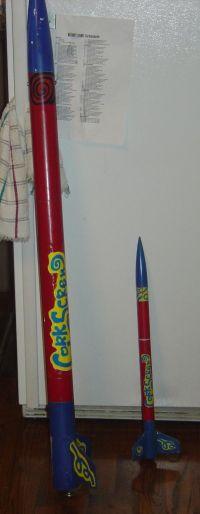Scratch Upscale Corkscrew Original Design / Scratch Built
Scratch - Upscale Corkscrew {Scratch}
Contributed by Taylor Jessee
Brief:
This is a single-staged mid- to high-power rocket that is an upscale of a kit I got 5 years ago for Christmas from my dad when I was 6 years old. I loved that original rocket because it made the curly smoke trail.
Construction:
The parts list:
- 1 36" PML Quantum Tubing made into a 25" main tube and 11" payload bay with coupler
- 3 1/8" thick plywood fins
- 2 1/4" thick plywood centering rings
- 1 8" long 29mm motor tube
- 3ft nylon shock cord
- 1 9" long x 2" diameter nose cone
- 2 rail buttons from blacksky Rocketry
- 1 1.75" long x 1/8" bolt
- 2 1/8" nuts
- 1 1" washer
- 2 X Corkscrew upscaled decals from Tango Papa
I started by cutting 11" from the top of the tube for the payload section. I then put the nosecone on and put screws in to hold it on. One of the tricky parts on the rocket was cutting the slots for the fins. I took the normal sized corkscrew and marked where the fins were with a Sharpie marker and a ruler, and cut them with a Dremel Tool. Next, I made the centering rings. I traced my coupler onto a piece of 1/4" plywood and traced my motor tube an 1/8" from one side and 3/4" from the other side the same with the other except it was traced in the center. My dad then cut them with his jigsaw. To make the fins, I had to measure the little ones and upscale them. When you mount the fins through wall like I did, you should leave about 2" on the fin tabs so you can stick them in the slots so you have more than enough to carefully measure and then cut them down until they mount flush against the airframe as well as against the crooked MMT. I glued the centering rings to the motor tube and glued the fins in. I then glued the shock cord down about 5" inside the Quantum Tubing.
One very important thing about using Quantum Tubing is you have to sand the areas where epoxy will be applied. I finished the build by gluing the coupler in place and screwed in the rail buttons.
Finishing:
I painted the nosecone and fin section blue. The rest was painted red. I applied the decals as shown on the corkscrew box that the original kit came in.
Flight:
We drove up to LDRS 24 from Kansas City, MO, and I flew my new Corkscrew up there. I first went to a vendor and bought a G38-7FJ. I made small tape ring around it for a thrust ring and inserted the motor into the rocket. For motor retention, I had a bolt drilled through the back of the centering ring with 2 nuts and a washer holding the motor in place. I did not need wadding because I used a Nomex pad to protect the parachute. I loaded the parachute, put it on the rail, and stuck the igniter in. My heart was in my mouth by the time as the LCO gave the countdown. I was amazed to see it fly perfectly with a swirling smoke trail and everything.
I can't wait to fly it someday on a H128!
Recovery:
At apogee, the ejection charge fired but the parachute didn't come out. The rocket landed hard. The parachute didn't come out because I didn't wrap the parachute tight enough and it got caught on some glue inside the airframe. One of the fins broke clean on landing and should be easy to fix.
Summary:
I think this rocket is great and is now one of my favorites.
Sponsored Ads
 |
 |












